Click links below to view the Rock Lobster bikes in our collection:
1987 Rock Lobster SS#11988 Rock Lobster SS#2
1991 Rock Lobster MODA
1991 Rock Lobster
1992 Rock Lobster
1993 Rock Langostino
1993 Rock Lobsterr
1996 Rock Lobster ADG
2007 Rock Lobster Nontrager
2007 Rock Lobster Big Stinky
|
From the Rock Lobster web site ORIGIN OF SPECIES I spent my entire childhood obsessed with bicycles and riding. Bicycling has been the predominant activity of my life other than eating and sleeping and making a living. My first lightweight racing bike came my way at age 13 and with it came a tremendous amount of freedom to move about; venturing many miles from home. Out of this childhood obsession a livelihood has emerged for me, first as a bicycle mechanic in 1976 , 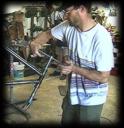 and as a full-time bicycle frame builder in 1988. I actually built my first
frame in 1978 and kept building as a hobbyist until the onslaught of telephone
frame orders made it necessary for me to quit my job and build frames fulltime.
My initial inspiration to build bicycle frames was borne out of necessity; I
couldnt afford to buy a custom frame and figured that I would save a lot of
money and learn a lot more by attempting to build my custom frame myself. The
challenge suited my obsessive nature at the time and the process was completely
foreign and fascinating to me. Many hours of blunders and frustration did little
to deter me after the first frame, so off I went to build one for my sister,
then another one for a friend. I just couldnt stop; I was sure that the next
one would redeem me for the previous one with all of its imperfections. Now that
I have been trying to redeem myself for over twenty years, the bikes have gotten
to new heights of quality. My frames have been ridden at the Olympics and at
world championship cyclocross and mountain bike events in many parts of the
world . Since a lot of much better riders than myself have given me input on the
performance of my bikes, the development and sophistication of my frame building
has been tremendous over my career. The thing that I have avoided is delegating
any of the building process to others, except for painting. In other words if
the frame has my signature on it, you can be sure that I built it. I dont have
a production line in my shop and most likely never will. I want each frame to be
as personal as the one I would build for myself This ethic makes for slower
delivery than the bigger companies, but it also enables me to build the kind of
frames that are too special to duplicate any other way. If you are willing to
wait a couple of months, it could pay off in many years of the best fit and
performance possible in a bicycle. Just ask someone riding a Rock Lobster.
and as a full-time bicycle frame builder in 1988. I actually built my first
frame in 1978 and kept building as a hobbyist until the onslaught of telephone
frame orders made it necessary for me to quit my job and build frames fulltime.
My initial inspiration to build bicycle frames was borne out of necessity; I
couldnt afford to buy a custom frame and figured that I would save a lot of
money and learn a lot more by attempting to build my custom frame myself. The
challenge suited my obsessive nature at the time and the process was completely
foreign and fascinating to me. Many hours of blunders and frustration did little
to deter me after the first frame, so off I went to build one for my sister,
then another one for a friend. I just couldnt stop; I was sure that the next
one would redeem me for the previous one with all of its imperfections. Now that
I have been trying to redeem myself for over twenty years, the bikes have gotten
to new heights of quality. My frames have been ridden at the Olympics and at
world championship cyclocross and mountain bike events in many parts of the
world . Since a lot of much better riders than myself have given me input on the
performance of my bikes, the development and sophistication of my frame building
has been tremendous over my career. The thing that I have avoided is delegating
any of the building process to others, except for painting. In other words if
the frame has my signature on it, you can be sure that I built it. I dont have
a production line in my shop and most likely never will. I want each frame to be
as personal as the one I would build for myself This ethic makes for slower
delivery than the bigger companies, but it also enables me to build the kind of
frames that are too special to duplicate any other way. If you are willing to
wait a couple of months, it could pay off in many years of the best fit and
performance possible in a bicycle. Just ask someone riding a Rock Lobster.
|
| 1978 |
|
The first two Paul Sadoff-built frames were made in Ross Shafer's shop in 1978 when he was building "Red Bush" frames. After that, still in 1978, Paul put together his own shop in a garage, where he was renting a room, and built and painted two more frames. Paul raced on the road from 1978 through 1981. The first 6 frames were called Routier after the road where Paul was living (Routier Street). Routier is French for "Truck driver", maybe not the best name for a bike? |
| 1979 |
|
Paul moved to another house, with a garage, and built a few more frames in 1979. Later that year Paul moved to an apartment, with his girlfriend, and spent two years there building about seven frames there. After the first 6 or so frames, the next 10 or 15 frames were labeled with the Sadoff name below a hand painted fleur-de-lis. |
| 1981 |
|
Paul's girlfriend kicked him out in August of 1981. He moved in to a little concrete outbuilding, on a ranch, and was shop-less for about 8 months. |
| 1982 |
|
Paul moved out of there in January 1982 and into a house closer to town, but still had no shop. The owner of the bike shop where he was working, the Bicycle Trip, got interested in frame building and offered to share his garage. So Paul began building again in February 1982. The boss never did build a frame but Paul built about 300 frames in that garage over the next ten years. In August 1982, Paul moved into a house on the shop property so now he lived at his shop. |
| 1984 |
|
Built the first Rock Lobster mountain frame. The frames were now labeled Rock Lobster after Paul had taken in a B-52's show at a local club a couple of years earlier. |
| 1987 |
|
Built the first Rock Lobster single speed frame. |
| 1988 |
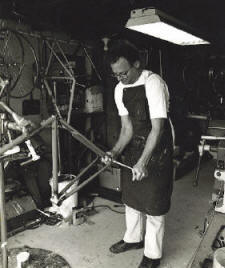 In 1988, Paul took out a business license and quit his other jobs to build frames full-time. Paul competes in his first MTB race, the 1988 Tahoe to Truckee. He wins the single speed class. Below is a picture of Paul fixing a Ritchey mountain bike in 1988. |
| 1989 |
|
Worked with Keith Bontrager doing production brazing on the race forks (dropouts and canti bosses). According to Paul " while I was working there I saw a guy from next door working on what was to be the first Rock Shox talking with Keith a lot....it was Paul Turner, of course." And we know how that story ended. |
| 1991 |
|
First Rock Lobster aluminum frame, circa 1991.  November 1991 Mountain Bike Action 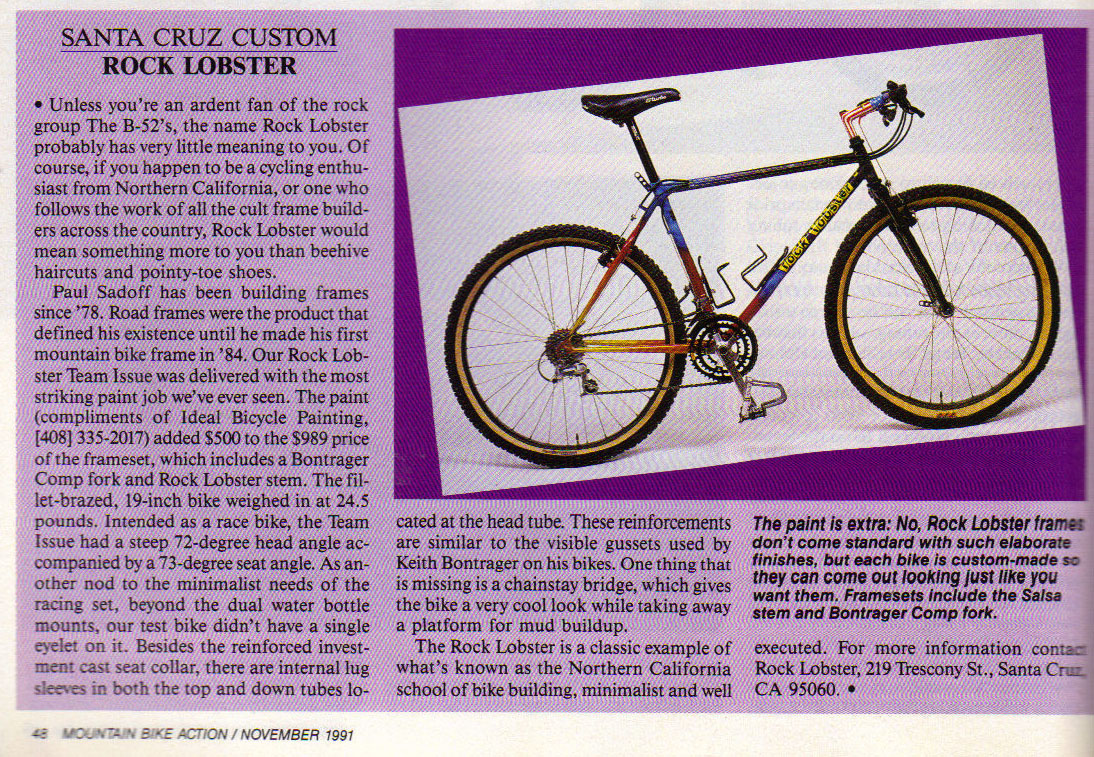
|
| 1992 |
|
Paul did some production stem brazing for Salsa. Worked for Kestrel from 1992 through 1995 doing road bike geometry consulting and prototype construction. Below, Paul is on bass at Salsa Fest 1992 with Ross Shafer on vocals. 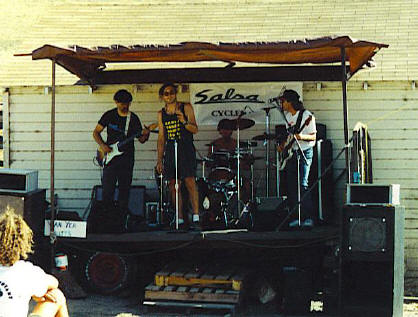 N November 1992 Bicycle Guide magazine builder profile: 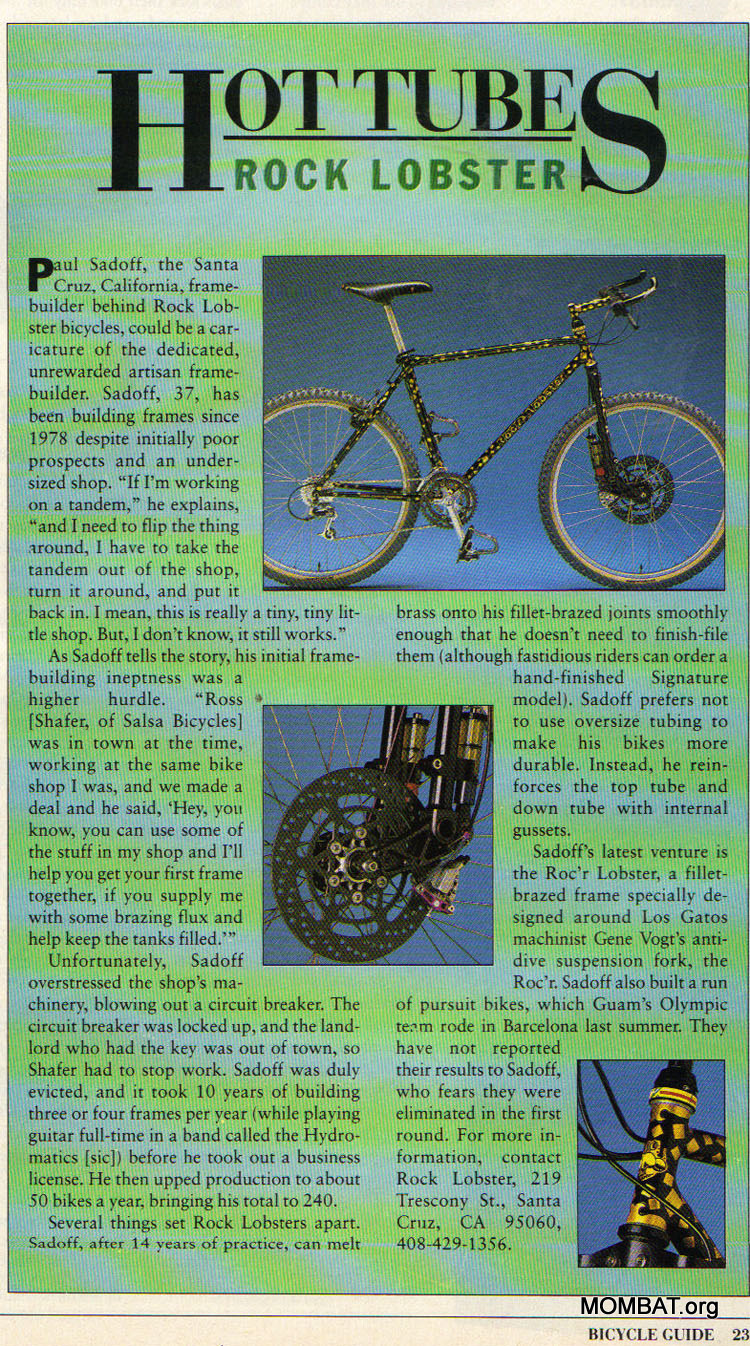 |
| 1993 |
|
In 1993, Paul moved to a larger shop because of the need for more space. This shop was located at Gross Road. The building was a 450 square foot corrugated metal out building which shared a lot with a restaurant. Paul built about 250 frames there. |
| 1994 |
|
Paul designed a bladed frame called the "airfoil" (seen to the right). It was originally designed for his sister, who lived in Manhattan. It was 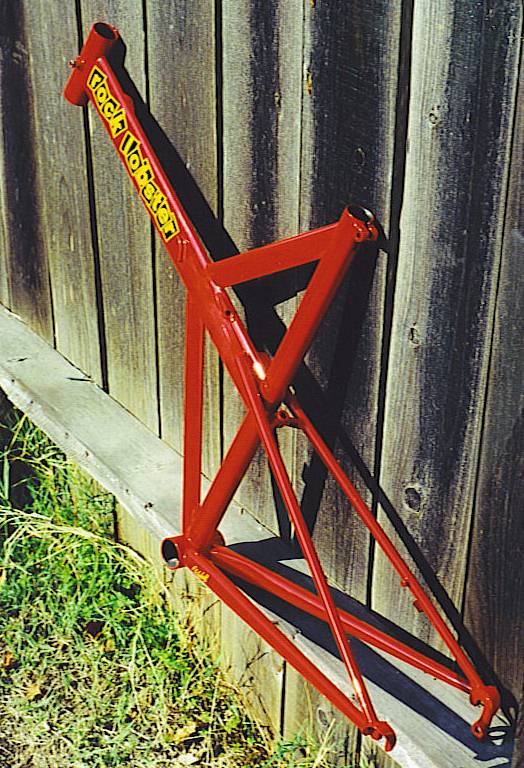 specially made to make people look. Paul got the idea from a
1994 one-off time trial bike made by Bianchi for Evgeni Berzin. The Rock
Lobster frame is a little different than the Bianchi and was made
with different materials. The Rock Lobster Expert joins the
family. Paul designed this frame and had it produced in Taiwan.
You got the great Lobster design for the bargain basement price of $395.
The frame featured Tange main tubes, Cro-Moly wishbone stays, gusseted
down tube, top routed cables, suspension correct geometry, Ritchey
dropouts, 71/73 geometry, 15/17/19" sizes and your choice of blue or
green. The frames came with a 2 year warranty which was handled by
Rock Lobster directly. Gekko Cycles, in Germany, bought Expert
frames to resell in Germany. Pauls second MTB race is the Humbug
Hurryup , where he was the second to last finisher on the long course
(single speed).
specially made to make people look. Paul got the idea from a
1994 one-off time trial bike made by Bianchi for Evgeni Berzin. The Rock
Lobster frame is a little different than the Bianchi and was made
with different materials. The Rock Lobster Expert joins the
family. Paul designed this frame and had it produced in Taiwan.
You got the great Lobster design for the bargain basement price of $395.
The frame featured Tange main tubes, Cro-Moly wishbone stays, gusseted
down tube, top routed cables, suspension correct geometry, Ritchey
dropouts, 71/73 geometry, 15/17/19" sizes and your choice of blue or
green. The frames came with a 2 year warranty which was handled by
Rock Lobster directly. Gekko Cycles, in Germany, bought Expert
frames to resell in Germany. Pauls second MTB race is the Humbug
Hurryup , where he was the second to last finisher on the long course
(single speed). |
| 1994 |
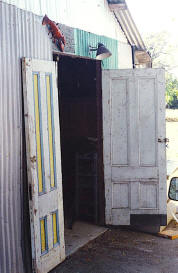 Paul rode the 1995 Paris-Brest-Paris and finished with a time of 83 hrs, 56 min. and finished with the sorest ass in France. The Gross Road shop entrance is shown above. |
| 1996 |
|
Paul moved into his current shop in July of 1996 where he shared space with another local builder, Rick Hunter. |
| 1997 |
|
End of the line for the imported Expert model. Severed ties with Gekko Cycles when the refused to pay licensing fees. |
| 1998 |
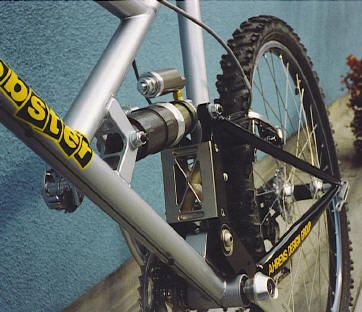 A full suspension frame was a
designed in conjunction with Mike Ahrens, who Paul still works with is
shown to the left..
Rick Hunter moves out of the shop which leaves Paul with all 550 square feet.
Bontrager shut down frame production, after the Trek buyout, and Paul bought the
leftover frame building materials. This lead to the building of the
"Nontrager" bikes (Lobster built with Bontrager materials). A full suspension frame was a
designed in conjunction with Mike Ahrens, who Paul still works with is
shown to the left..
Rick Hunter moves out of the shop which leaves Paul with all 550 square feet.
Bontrager shut down frame production, after the Trek buyout, and Paul bought the
leftover frame building materials. This lead to the building of the
"Nontrager" bikes (Lobster built with Bontrager materials). |
| 1999 |
|
Paul starts Cyclocross racing with a best finish of 35th (UPDATE: Paul snagged a 27th place at the 2009 Cyclocross Nationals! older AND faster) in the 45-50 Masters category at the Napa, CA Nationals. There is a five year licensing agreement with a British company , The Merlin Cycles, Ltd. to sell the Expert model frame. So the Expert lives on in the jolly old U.K. Made a single frame using a 1.25" head set and Action Tec front suspension fork (Paul has also produced two bikes using the Cannondale Headshok system) |
| Production Numbers |
|
1978-1996 production of approximately 350 frames. 1997-present production approx. 550 frames. 2 airfoils, 6 tandems ( 2 road, 4 MTB), 12 full suspension, approx. 12 dual slalom, 8 Freeride hardtails, 94 "Nontragers", 1 fake Cinelli (built to replicate a customers damaged Cinelli), 3 H.P.V.'s , one snow bike, one Dutch-style town bike for Paul's wife, approx. 35 track bikes, 15 time trial bikes, one "circus bike", a 16" wheel MTB for a 2 1/2 year old, a 24" wheel triathlon bike for a 9 year old, a Cr�me Brule branding iron for a French restaurant, various structures for the garden, about 600 handlebar stems (15 for the Barracuda exhibit at the 1992 Interbike) Percentages have been about 40% road, 30% MTB, 25% 'cross , 5% other. The MTB numbers include approximately 100 single speeds. |
| Serial Numbers |
|
Numbers for steel frames: Numbers starting with any number from 1-9 indicate road frame. Numbers starting with 0 indicate fillet mountain frame. Numbers starting with 00 indicate TIG mountain frame. Number starting with N indicate Nontragers Numbers starting with 1-9 (indicates the year of manufacture) followed by 00 and any number indicate cross frame. Example: 9006 would be the sixth cross frame built in 1999. Current cross frames start with 24 to indicate 2004. ( 2406 for example) Numbers for aluminum frames: HCR followed by a number indicates an Easton road frame. AC followed by any number indicates Easton cross or mountain frame. SC followed by a number indicates scandium frame. ADG followed by any number indicates frames designed by Mike Ahrens. FA followed by any number indicates track frames made for Farid Abrahams riders of the San Jose Velodrome. |
MOMBAT links
Hours
Monday-Friday: 10-6
Saturday: 10-5
Sunday: Closed
MOMBAT t-shirts
Show your support for the MOMBAT with this great looking t-shirt.
"It doesnt get any easier, you just get faster." Greg LeMond
If you found something useful on this site, please consider making a donation to help defray the costs of bringing it to you. Thanks Jeff

